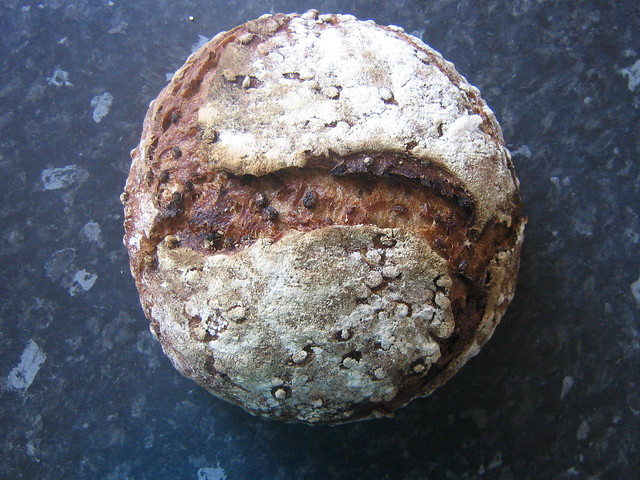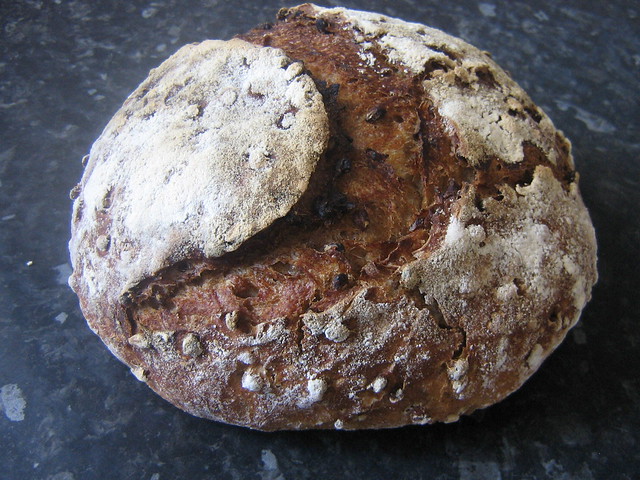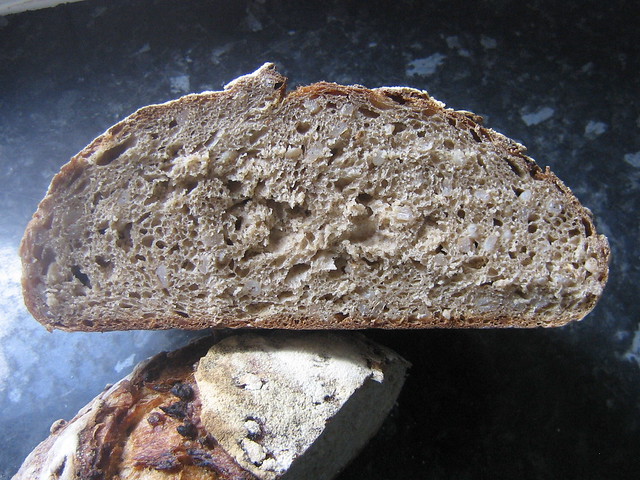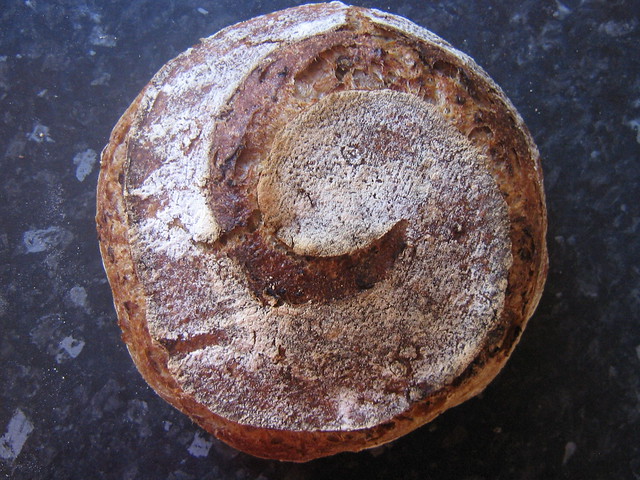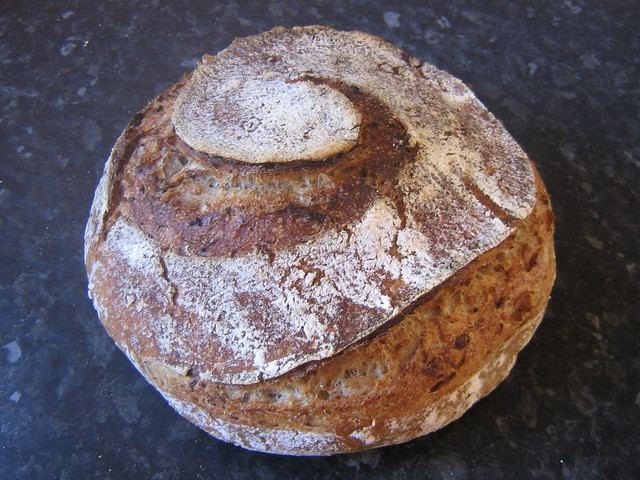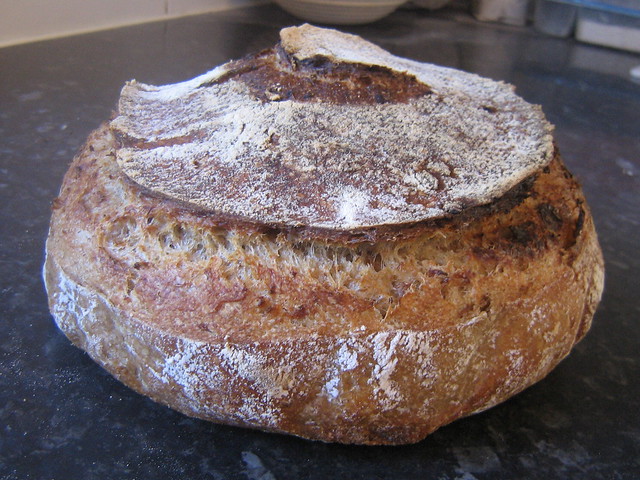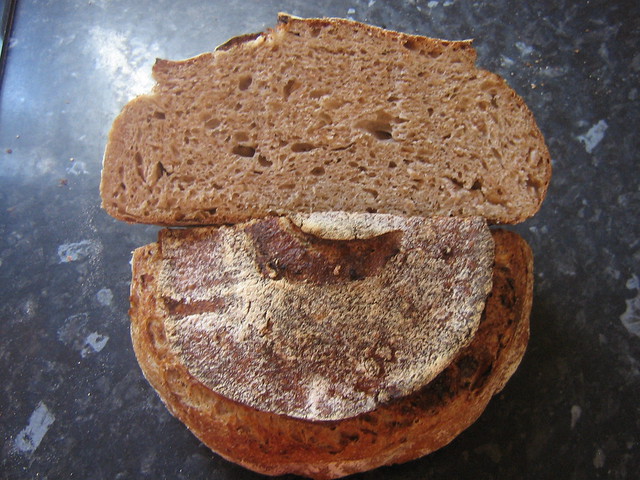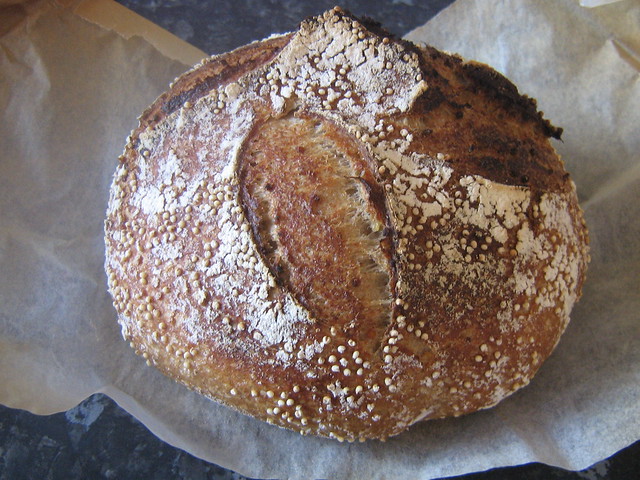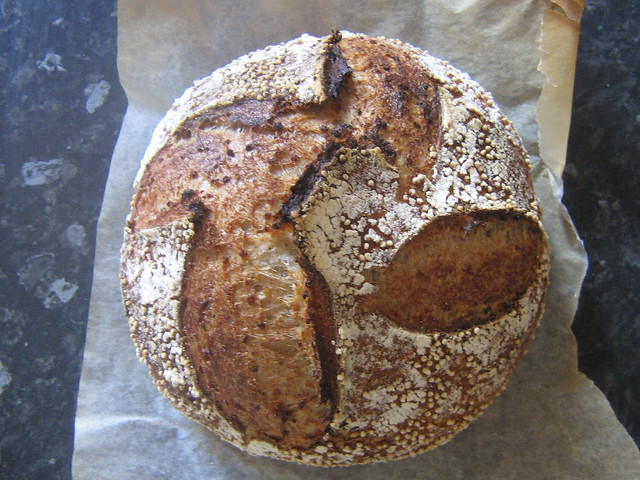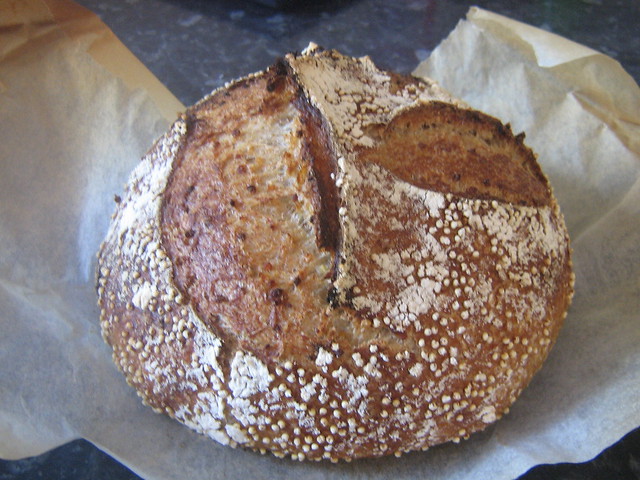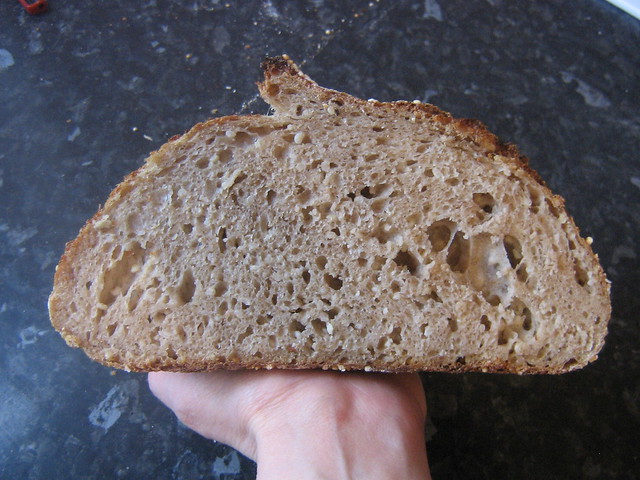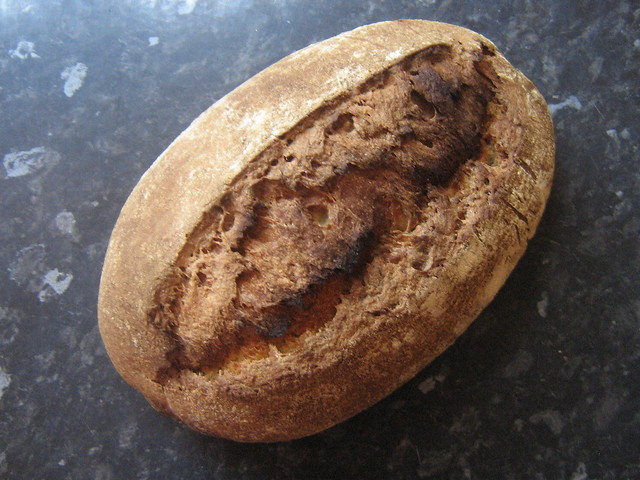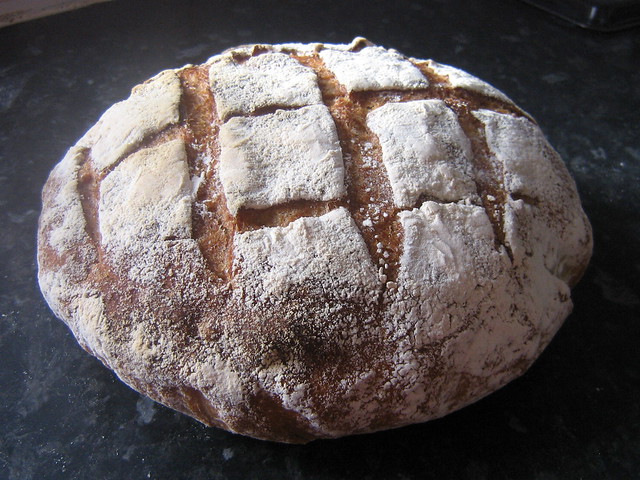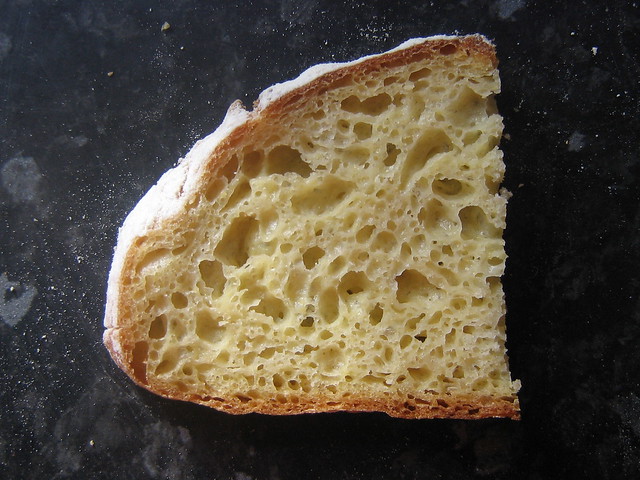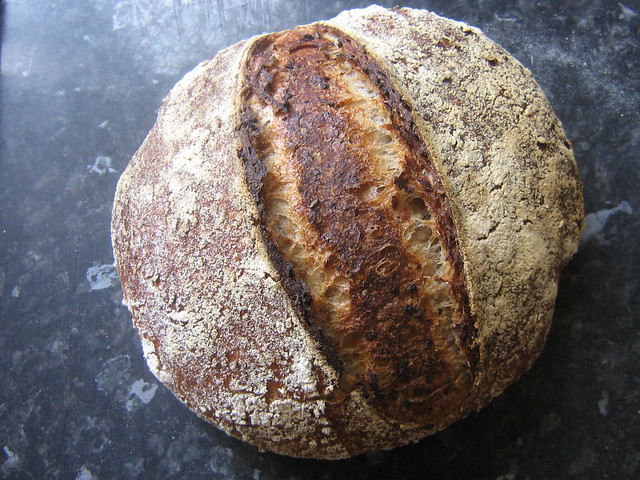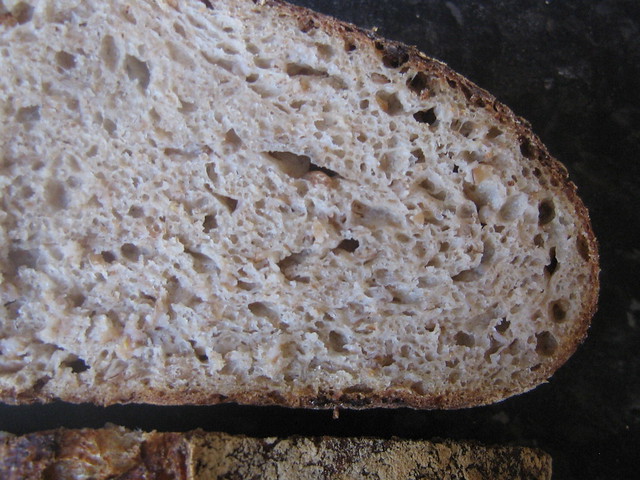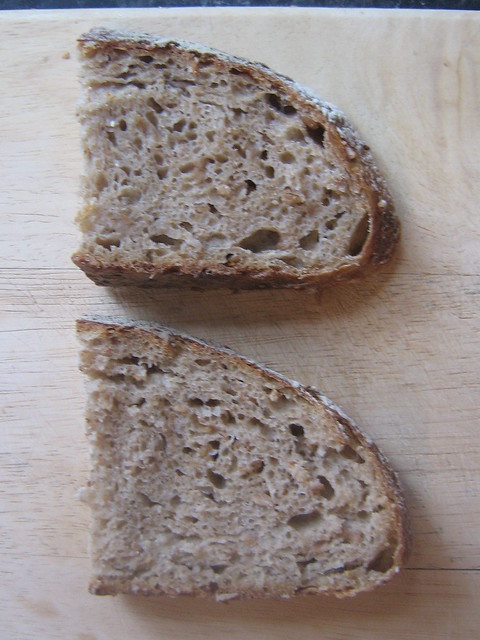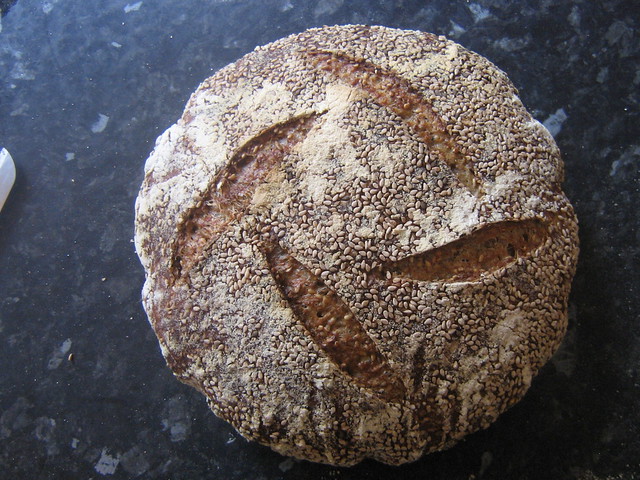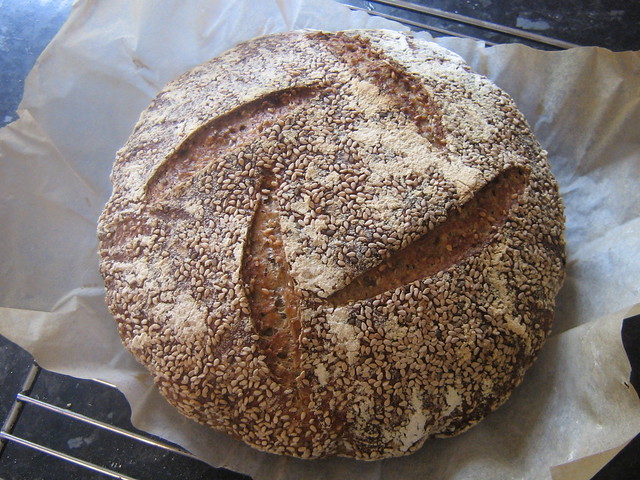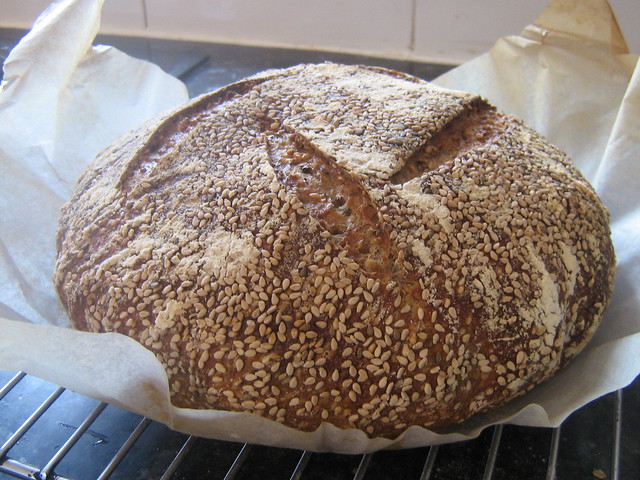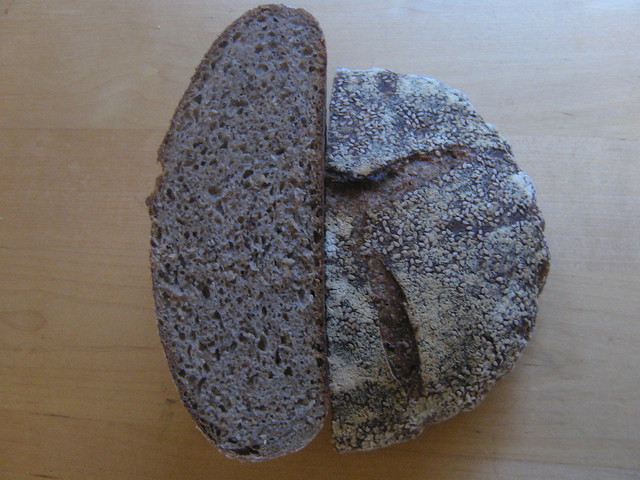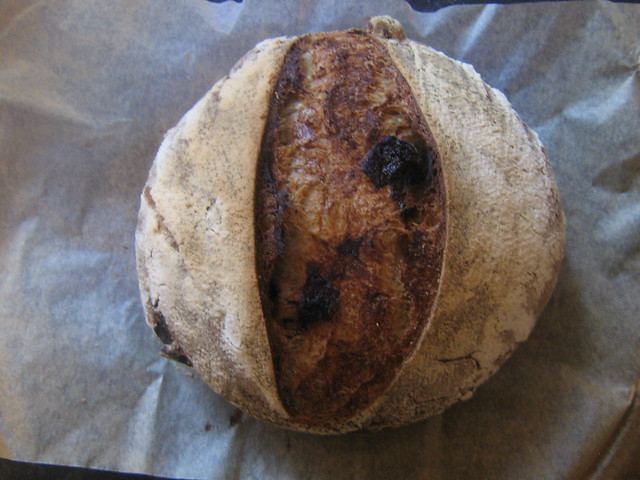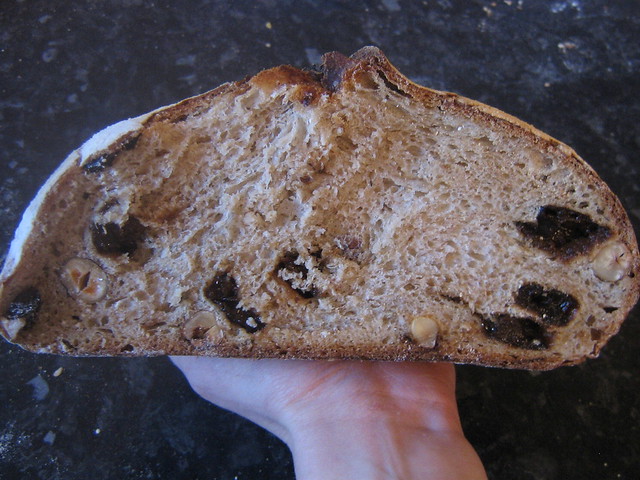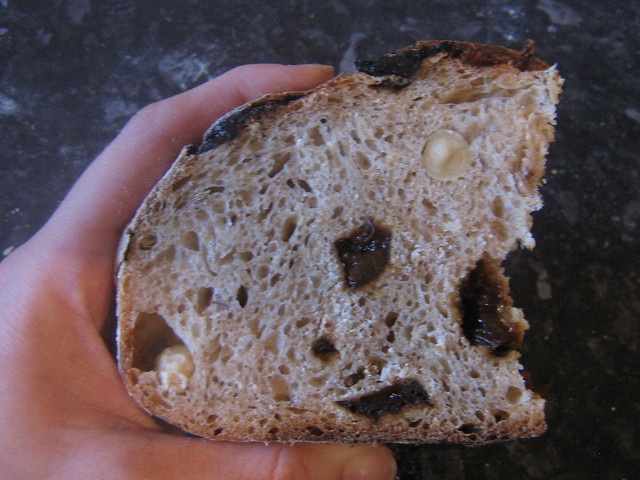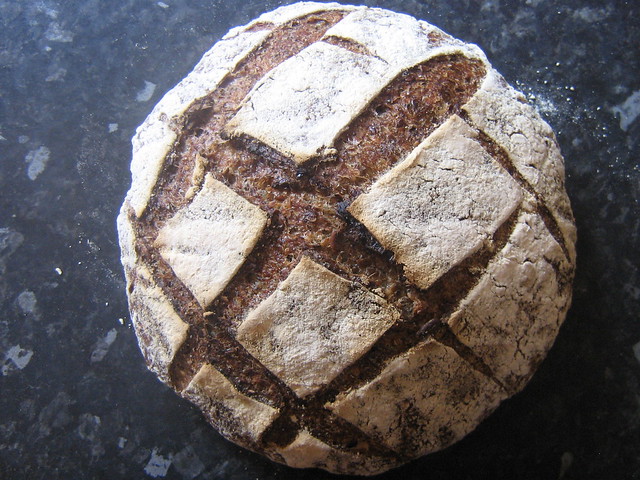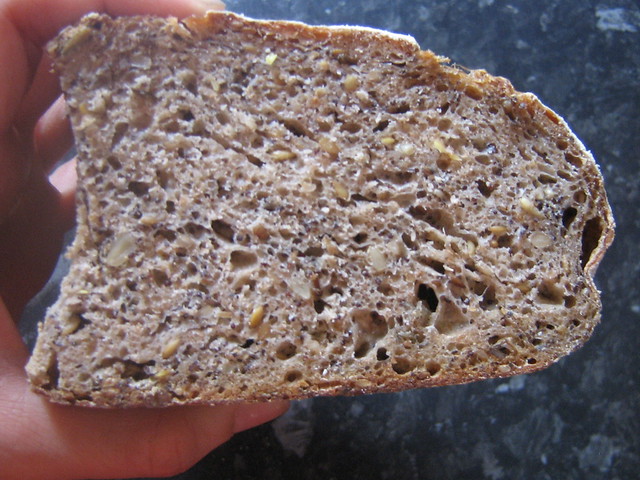After last weeks barley flop, I decided to try again. This time with Dan Lepard's barley bread recipe. I doubled the recipe and baked too large loaves. This bread has overall less barley flour but a lot of cooked barley added to the mix. I was hoping for a distinctive taste of barley but less stress than last week. The barley flour is lightly toasted in the oven for 10 minutes at 160 degrees fahrenheit. The smell of the toasted barley is quite strong, nutty and a little woody, this made the aroma of the dough very distinctively.
The barley grains were pot barley. In quite a few of the recipes in The Handmade Loaf, I've been swapping out cooked grains for sprouted grains. However, in this case this is not possible as hulling barley seems to damage the germ of the grain making it unable to sprout. Chad Robertson seems to think that purple barley varieties work better but these are only available from one supplier in the US. In this case, I simmered the barley for about 25minutes. They were cooked but still quite chewy.
The texture of the dough was initially extremely tough. It was difficult to include all of the flour and the dough felt like heavy clay. I reduced the honey to 20g per loaf and added an extra 50g of water per loaf to get a dough that was slightly more pliable than plasticine! The dough was similar to last week, a little stronger but clearly lacking gluten and soft rather than gummy like rye dough.
These loaves came out a lot better than the barley loaves from last week. I'm pleased with the result.
The second set of loaves I baked this week used the spelt porridge recipe from Tartine #3. I don't have too much to say about these loaves except I've decided to continue with 150g of leaven and retarding for 18 hours in the fridge.
I've tried to increase the hydration very slightly and used a little more water in the spelt flakes when making porridge as well. The spelt flakes absorb quite a lot of water so I add a little water so that they take about 5-10 minutes to cook. There is probably no need to cook the flakes and pouring boiling water on them would probably be sufficient. I've found there is a little bit of a difference between the two approaches as cooking seems to make the spelt flakes a little bit more glossy and gummy and they disappear into the dough more.
This is really lovely bread with a soft crumb. On the afternoon after being baked, the crust was thin crispy and totally irresistible. I'm coming round to the taste of spelt as a softer less bitter variety of wheat.
Happy Baking!
Sunday, 28 February 2016
Saturday, 27 February 2016
Not such a good week: Millet porridge bread and a lemon barley loaf
Continuing with the theme of sorting out the random baking ingredients I've collected the first type of bread I baked last week was a millet bread. Last week was a struggle, one of the set of loaves came out well and the other was a real challenge.
This bread is a simple 50-50 mix of white flour and high extraction flour with added cooked millet. The recipe is exactly as in Tartine #3 except I've scaled it to 400g of flour per loaf as my bannetons are not big enough for the porridge recipes. I've decided to continue with using 15% leaven and try to stretch the fermentation time out longer. It doesn't seem like we're going to get a proper winter in Manchester this year and daytime temperature is stubbornly above 5 degrees.
The cooked millet smells grassy and a little nutty - like bird seed and tastes a little grassy but fairly neutral. In terms of texture, it falls somewhere near quinoa and couscous or burghur wheat. Every time I cook some for this recipe I consider making salad or serving it as a side dish with a stew but it hasn't happened yet. I'd be curious to know how millet was traditionally eaten in Europe.
The very perky shape suggests I've slightly under fermented these loaves a little. This bread is simple, easy to make and doesn't smell anywhere near as much like bird seed after it is baked! The toasted millet on the surface is quite different – crunchy and nutty and pretty too.
Another one of those things in the back of the cupboard is bag of barley flour. Probably the safest thing to do with this would be to bake biscuits. I was tempted by the idea making bannock but settled on a recipe for a lemon barley loaf from Dan Lepard's 'The Handmade loaf'.
Lemon barley loaf
The recipe is 40% Barley flour and 60% white flour so I wasn't expecting the dough to behave like a wheat loaf but even though pretty much everything that could go wrong, did go wrong.
Most obviously, I forgot about the salt crust. The dough was difficult to handle as it seemed fragile and lacking structure, which makes sense with so much gluten-free barley flour. However this caused me to panic and just make matters worse with a whole series of mistakes.
The dough was soft and sticky but not in the same way that rye dough is as it lacks the cement-like gloss and gloopiness. I didn't feel confident shaping these batons as I haven't done this for ages. Things got worse at the scoring stage with the knife snagging and more tearing that cutting the dough. Finally, the loaves were significantly over baked giving a dull and thick crust.
The taste of this bread is unique and oddly appealing, so I can see that the recipe could be very special if executed a lot better than this attempt. A much more successful version of this bread has been posted on The Fresh Loaf by TXFarmer's and can be found here. At the moment I lack the skill and patience to recover once things start to veer of track which is disappointing.
Happy Baking!
This bread is a simple 50-50 mix of white flour and high extraction flour with added cooked millet. The recipe is exactly as in Tartine #3 except I've scaled it to 400g of flour per loaf as my bannetons are not big enough for the porridge recipes. I've decided to continue with using 15% leaven and try to stretch the fermentation time out longer. It doesn't seem like we're going to get a proper winter in Manchester this year and daytime temperature is stubbornly above 5 degrees.
The cooked millet smells grassy and a little nutty - like bird seed and tastes a little grassy but fairly neutral. In terms of texture, it falls somewhere near quinoa and couscous or burghur wheat. Every time I cook some for this recipe I consider making salad or serving it as a side dish with a stew but it hasn't happened yet. I'd be curious to know how millet was traditionally eaten in Europe.
The very perky shape suggests I've slightly under fermented these loaves a little. This bread is simple, easy to make and doesn't smell anywhere near as much like bird seed after it is baked! The toasted millet on the surface is quite different – crunchy and nutty and pretty too.
Another one of those things in the back of the cupboard is bag of barley flour. Probably the safest thing to do with this would be to bake biscuits. I was tempted by the idea making bannock but settled on a recipe for a lemon barley loaf from Dan Lepard's 'The Handmade loaf'.
Lemon barley loaf
The recipe is 40% Barley flour and 60% white flour so I wasn't expecting the dough to behave like a wheat loaf but even though pretty much everything that could go wrong, did go wrong.
Most obviously, I forgot about the salt crust. The dough was difficult to handle as it seemed fragile and lacking structure, which makes sense with so much gluten-free barley flour. However this caused me to panic and just make matters worse with a whole series of mistakes.
The dough was soft and sticky but not in the same way that rye dough is as it lacks the cement-like gloss and gloopiness. I didn't feel confident shaping these batons as I haven't done this for ages. Things got worse at the scoring stage with the knife snagging and more tearing that cutting the dough. Finally, the loaves were significantly over baked giving a dull and thick crust.
The taste of this bread is unique and oddly appealing, so I can see that the recipe could be very special if executed a lot better than this attempt. A much more successful version of this bread has been posted on The Fresh Loaf by TXFarmer's and can be found here. At the moment I lack the skill and patience to recover once things start to veer of track which is disappointing.
Happy Baking!
Friday, 26 February 2016
Catch up: Rye porridge bread and maize bread
This is a catch-up post about bread baked on 9th February which has been hanging about a couple of weeks waiting for editing.
Maize bread
The first bread I baked this week was a Pan de Mais using the straight dough recipe from 'The Handmade Loaf'. The loaf contains both maize flour and precooked polenta. The recipe requires buttermilk which I substituted with milk and half a tablespoon of vinegar stirred together and left for 15 minutes. My precooked polenta (50g) was cooked with 200g of water rather than 100g. This was a silly mistake, as I placed 100g of water on the polenta while stirring the milk and found it was absorbed before I got a chance to heat up the mixture!
The dough turned out to soft and extremely sticky, so I added enough extra flour to make it soft and fluffy. During the folds the dough seemed to turn into a giant bright yellow marshmallow… I was doubtful that that was a good thing but blindly continued, hoping for the best but fearing the worst. This dough raised extremely quickly! By the time the dutch oven had preheated the dough was precariously spilling out of the banneton and wobbling like a giant blancmange. The dough deflated a tiny bit on scoring but bounced back a little in the oven – crisis averted.
This bread was a real treat. It smells enticing and has a beautiful creamy soft crumb. I used this bread to make some grilled cheese sandwiches inspired by Jamie Olivers recipe. Amazing!
Rye porridge bread
Secondly, I baked Rye porridge bread using the last of the rye chops in the cupboard. This is one of the first breads from Tartine #3 that I got acceptable results from. I've tried quite a few variations with varying degrees of success, with and without extra rye flour, pre-fermented rye chops extra molasses, extra bread spices, extra walnuts are all viable and delicious options. However, on this occasion I decided to go back to basics and just bake the recipe exactly as in Tartine #3.
That includes reducing the amount of leaven back down to 15%. My loaves have had limited oven spring recently and rather than get up earlier or mix the dough later on in the evening I thought I'd just try retarding the shaped loaves a bit longer (about 18 hours). I'm pleased with the outcome.
Happy Baking!
Maize bread
The first bread I baked this week was a Pan de Mais using the straight dough recipe from 'The Handmade Loaf'. The loaf contains both maize flour and precooked polenta. The recipe requires buttermilk which I substituted with milk and half a tablespoon of vinegar stirred together and left for 15 minutes. My precooked polenta (50g) was cooked with 200g of water rather than 100g. This was a silly mistake, as I placed 100g of water on the polenta while stirring the milk and found it was absorbed before I got a chance to heat up the mixture!
The dough turned out to soft and extremely sticky, so I added enough extra flour to make it soft and fluffy. During the folds the dough seemed to turn into a giant bright yellow marshmallow… I was doubtful that that was a good thing but blindly continued, hoping for the best but fearing the worst. This dough raised extremely quickly! By the time the dutch oven had preheated the dough was precariously spilling out of the banneton and wobbling like a giant blancmange. The dough deflated a tiny bit on scoring but bounced back a little in the oven – crisis averted.
This bread was a real treat. It smells enticing and has a beautiful creamy soft crumb. I used this bread to make some grilled cheese sandwiches inspired by Jamie Olivers recipe. Amazing!
Rye porridge bread
Secondly, I baked Rye porridge bread using the last of the rye chops in the cupboard. This is one of the first breads from Tartine #3 that I got acceptable results from. I've tried quite a few variations with varying degrees of success, with and without extra rye flour, pre-fermented rye chops extra molasses, extra bread spices, extra walnuts are all viable and delicious options. However, on this occasion I decided to go back to basics and just bake the recipe exactly as in Tartine #3.
That includes reducing the amount of leaven back down to 15%. My loaves have had limited oven spring recently and rather than get up earlier or mix the dough later on in the evening I thought I'd just try retarding the shaped loaves a bit longer (about 18 hours). I'm pleased with the outcome.
Happy Baking!
Labels:
maize bread,
pan di mais,
rye porridge,
Tartine #3,
The handmade loaf
Tuesday, 9 February 2016
Sesame Wheat and a Prune and Hazelnut Leaven
This week feels a little less hectic, last week I was signed-off as fully trained in my volunteering role. While I'm really pleased to have got this far, the process really scrambled my brains for a couple of days. This week I've swapped my shifts about to start working some mornings so as to have more free time at the beginning of the week (for baking). It has been lovely to bake bread without as much time pressure this week and really let the bread develop at it's own pace.
Sesame-Wheat bread
First up this week, the next seeded bread in Tartine #3 which has added whole wheat flour and toasted sesame seeds. This is an unapologetically bold and brash bread. Chad Robertson says it is the bread that drove him to become a baker and I can see why. The smell alone is irresistible.
As usual, due to cool weather, I increased the starter to total of 300g and tweaked the hydration a little as I expected the sesame seeds to absorb some additional water. For two large loaves, the overall formula without listing the starter as a separate ingredient was as follows:
The sesame seeds were toasted in advance in small batches. The sesame seeds pop like crazy and either refuse to toast much at all or spring all over the kitchen! Immediately after shaping, the loaves were retarded in the fridge for about 12 hours.
So the loaves came out (as usual) not as open as would be ideal. I think I'm a bit heavy handed with shaping. However, the aroma and taste was incredible and the lack of medium/large holes did help when making grilled cheese sandwiches.
A few years ago, while living in student accommodation, I ate virtually only fruit bread (toasted with jam) and toasted cheese sandwiches for a whole semester. The motivation for this being that I did not have to brave the mess in the shared kitchen and could stay in my bedroom studying in peace. After a while, the store bought bread was oddly addictive despite tasting dreadful. I literally broke this habit when melted cheese short-circuited my toasted sandwich-maker.
Since then I've had an on-off relationship with fruit bread. Some recipes are so soft, fluffy and cake-like that I wish I had just made scones instead. This next recipe is definitely on the more bread-y, less cake-y end of the spectrum.
Prune, hazelnut and fennel leaven
This bread was inspired by STUinLouisa's spring cleaning post on The Fresh Loaf. The nuts and dried fruit in the cupboard were, unfortunately, limited to 70g of hazelnuts and 160g prunes left over from Christmas.
I decided to use these to make a small variation on the 'toasted hazelnut and prune bread' in Hamelman's Bread. Hamelman's original recipe includes some dried yeast making it unsuitable for retarding overnight. The only changes I made were to add one tablespoon of fennel seeds and omit the yeast. I also extended to bulk fermentation to 2.5hrs and retarded the loaves overnight so that they would fit my schedule better.
Wonderfully tasty bread and makes very good toast. Normally a fruit and nut loaf like this would disappear extremely quickly due to DH's midnight snacking habits but this week the sesame seed bread was nibbled instead.
Happy Baking!
Sesame-Wheat bread
First up this week, the next seeded bread in Tartine #3 which has added whole wheat flour and toasted sesame seeds. This is an unapologetically bold and brash bread. Chad Robertson says it is the bread that drove him to become a baker and I can see why. The smell alone is irresistible.
As usual, due to cool weather, I increased the starter to total of 300g and tweaked the hydration a little as I expected the sesame seeds to absorb some additional water. For two large loaves, the overall formula without listing the starter as a separate ingredient was as follows:
| Ingredient | Weight | Bakers percentage |
|---|---|---|
| High extraction wheat flour | 425g | 40% |
| White bread flour | 375g | 35% |
| Wholegrain wheat flour | 275g | 25% |
| Wheat germ | 900g | 6.5% |
| Water | 275g | 84% |
| Salt | 25g | 2.3% |
| Toasted sesame seeds | 250g | 23% |
The sesame seeds were toasted in advance in small batches. The sesame seeds pop like crazy and either refuse to toast much at all or spring all over the kitchen! Immediately after shaping, the loaves were retarded in the fridge for about 12 hours.
So the loaves came out (as usual) not as open as would be ideal. I think I'm a bit heavy handed with shaping. However, the aroma and taste was incredible and the lack of medium/large holes did help when making grilled cheese sandwiches.
A few years ago, while living in student accommodation, I ate virtually only fruit bread (toasted with jam) and toasted cheese sandwiches for a whole semester. The motivation for this being that I did not have to brave the mess in the shared kitchen and could stay in my bedroom studying in peace. After a while, the store bought bread was oddly addictive despite tasting dreadful. I literally broke this habit when melted cheese short-circuited my toasted sandwich-maker.
Since then I've had an on-off relationship with fruit bread. Some recipes are so soft, fluffy and cake-like that I wish I had just made scones instead. This next recipe is definitely on the more bread-y, less cake-y end of the spectrum.
Prune, hazelnut and fennel leaven
This bread was inspired by STUinLouisa's spring cleaning post on The Fresh Loaf. The nuts and dried fruit in the cupboard were, unfortunately, limited to 70g of hazelnuts and 160g prunes left over from Christmas.
I decided to use these to make a small variation on the 'toasted hazelnut and prune bread' in Hamelman's Bread. Hamelman's original recipe includes some dried yeast making it unsuitable for retarding overnight. The only changes I made were to add one tablespoon of fennel seeds and omit the yeast. I also extended to bulk fermentation to 2.5hrs and retarded the loaves overnight so that they would fit my schedule better.
Wonderfully tasty bread and makes very good toast. Normally a fruit and nut loaf like this would disappear extremely quickly due to DH's midnight snacking habits but this week the sesame seed bread was nibbled instead.
Happy Baking!
Tuesday, 2 February 2016
Busy week: Seeded Wheat
The week before last was unexpectedly hectic so I only baked one type of bread.
Seeded Wheat
I scaled the recipe to a total of 400g of added flour per loaf. I also decreased the caraway seeds to just 1.5% and increased the hydration so that the overall hydration (including water from the starter but not flaxseeds) was 87%. It was a push to bake the loaves the same day they were shaped so they were not as risen as I would have liked before baking.
Luckily the bread seems to have not suffered too much from the time constraints. This bread couldn't contain many more seeds without turning into muesli! It tastes lovely sliced thinly and smothered in cream cheese.
It was DH's birthday this weekend so baked mini chocolate cakes with cream cheese frosting. I'm really pleased that my piping skills are very slowly getting better.
Happy Baking!
Seeded Wheat
I scaled the recipe to a total of 400g of added flour per loaf. I also decreased the caraway seeds to just 1.5% and increased the hydration so that the overall hydration (including water from the starter but not flaxseeds) was 87%. It was a push to bake the loaves the same day they were shaped so they were not as risen as I would have liked before baking.
Luckily the bread seems to have not suffered too much from the time constraints. This bread couldn't contain many more seeds without turning into muesli! It tastes lovely sliced thinly and smothered in cream cheese.
It was DH's birthday this weekend so baked mini chocolate cakes with cream cheese frosting. I'm really pleased that my piping skills are very slowly getting better.
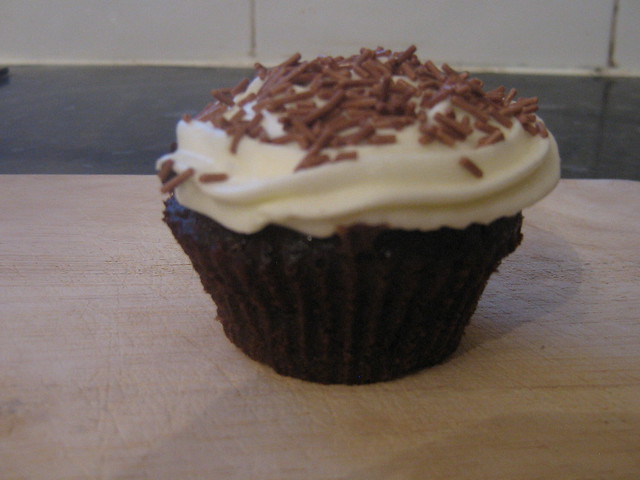 | 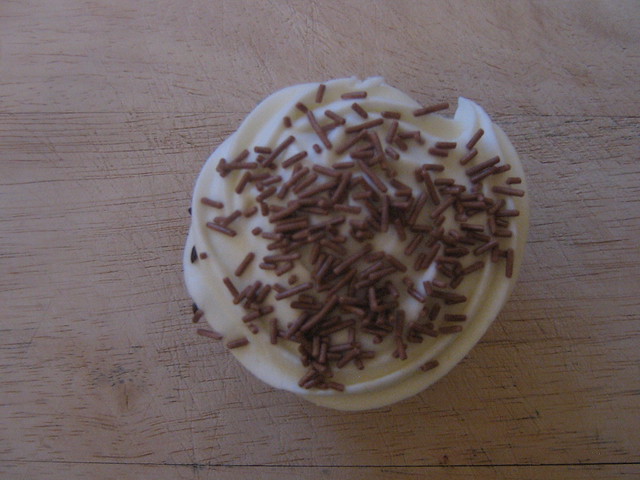 |
Happy Baking!
Subscribe to:
Posts (Atom)
